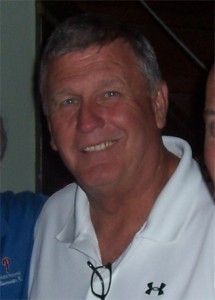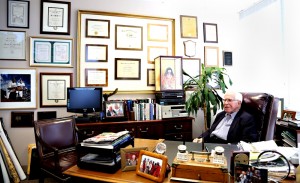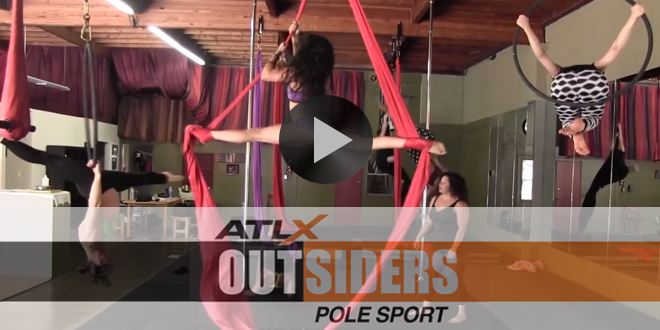By: Morgan Urtso
 He practically hand-laid each individual brick that paved the way for the entire field of sports medicine. A true pioneer in the field, Dr. Frank Jobe changed the game when he developed and performed the first ulnar collateral ligament (UCL) reconstruction on the throwing elbow of MLB pitcher Tommy John in 1974.
He practically hand-laid each individual brick that paved the way for the entire field of sports medicine. A true pioneer in the field, Dr. Frank Jobe changed the game when he developed and performed the first ulnar collateral ligament (UCL) reconstruction on the throwing elbow of MLB pitcher Tommy John in 1974.
John went on to win 164 games –40 more than before his surgery– and extended his career until 1989. The success of Dr. Jobe’s revolutionary procedure, appropriately nicknamed “Tommy John surgery,” earned the deserved respect that skyrocketed the sports medicine industry to necessity and relevance.
Nearly 40 years later, Dr. Jobe sits atop the world-renowned Kerlan-Jobe Orthopaedic Clinic, a practice he co-founded decades ago. He sat down with ATLX to discuss that first procedure, the field of sports medicine, and the path that led him to it.
On Tommy John:

ATLX
Tell me about that initial procedure for Tommy John. Did you realize the potential magnitude?
DR. JOBE
No way. I was just trying to do what he wanted done and hoped that it worked! That’s the reason I didn’t do any more for two years, because I didn’t know if that was going to hold up or not. And it hadn’t been done quite like that before. So we planned the surgery. I knew I could do it, but whether it would stand up under the pitching stress, I didn’t know.
ATLX
So those were the reservations, whether it would last, if it would work at all …
DR. JOBE
Yes. And that’s why I told him he didn’t have any chance if he didn’t have it done. He had about one in a hundred if he did have it. He said, “That’s better than nothing. Let’s do it.”
ATLX
How did Tommy John approach dealing with that injury?
DR. JOBE
At first we kind of tried to just cast it to see if it would heal. I think it healed some, but not enough to hold up on throwing. He could throw maybe 75 percent of what he would throw ordinarily. That’s not enough to get anybody out. So he said, “You got to think of something!”
So I outlined what he might do, and he came back a couple weeks later. This was in our old office … it was almost 40 years ago. We looked at each other and he said, “Let’s do it.” Those were the key words.
ATLX
It was such a revolutionary thing at the time. How did you even begin to develop the procedure?
DR. JOBE
I knew I could transfer a tendon. I’d done that with polio patients. But I didn’t know whether or not it would revascularize and be strong like a ligament under stress. That’s why I didn’t do any more for a couple of years; I had to see how that first one would work out. Then I realized that maybe this was something I could use! Then I did a few more, then a few more … now every Major League team has at least one Tommy John pitching on their staff.
ATLX
So since that first time, has the procedure changed much?
DR. JOBE
Very little. The principle is that you get some collagen across the joint – tight as you can get it – and have it revascularized from natural blood vessels invading it. When I realized that that was going to happen – it wasn’t just going to be a dead piece of tendon there – then that was encouraging. And the fact that Tommy John was able to go 14 years and never miss a start and won 164 more games…
On the growth of sports medicine:

ATLX
How revolutionary has the Tommy John procedure proven to be for the game of baseball? It’s really been a game changer.
DR. JOBE
I think it has been great. Before that, if someone got a ligament torn, they couldn’t pitch effectively, so they were sent back to wherever they came from. And no attempt was made to do surgery.
In those days, there was no such thing as American Orthopedic Society for Sports Medicine — that was formed in ’72. And then the Shoulder and Elbow Society was formed ten years later. Before that, there was no particular attention directly paid to sports injuries.
And back then it was not so important to have a doctor present at the games. I would go to spring training with the Dodgers, and people would say, “What are you doing down here, taking a little vacation?” Now it’s mandatory that a doctor be available at games and spring training. This attitude of medicine in sports, the attitude of the players and management and ownership has changed.
ATLX
The safety of players has become so much more important. It’s about career extension. The involvement of sports medicine is a good thing.
DR. JOBE
It is a very good thing. I remember it used to be that there was one doctor at a football game. I was just talking to a doctor for the Bears, and he has six doctors on staff at every game. He needs an anesthesiologist, he needs a neurologist, he needs an orthopedist, an internist… all the specialties are represented to take care of the player right now.
ATLX
With sports medicine, more and more athletes are undergoing surgeries like Tommy John or ACL procedures, and they come back even better than before.
DR. JOBE
Do you know why? It’s not the surgery. It’s the whole program. You get the knee stable or the shoulder stable or the elbow stable, and they rehab the entire body, not just the injured area. Rehabilitation and maintenance of good conditioning is so much more important now than it used to be. When I first came to the Dodgers, they didn’t even have a weight room.
You see a lot of athletes getting surgery, and they say, “The surgery is really great. You better get it, because it makes you better than you ever were before.” But it’s not true. The rehab is better. The total picture. You have a combination of surgery, rehabilitation, hard work, psychological support, practice and you get better. Of course, they think it’s just the surgery!

ATLX
The field has really come a long way.
DR. JOBE
Yes. What’s very fortunate is I’ve lived in an era when medicine was advancing very rapidly. And the term sports medicine was just being started at the time I went into practice. I remember a lot of older doctors used to say, “Tell me the difference between a fractured tibia in an athlete and one in a lawyer?” They kind of teased me about what sports medicine was – how was it any different from regular medicine? It’s hard to figure that out, you know? But I think I know.
ATLX
And now there’s the Kerlan-Jobe Orthopaedic Clinic. You built this huge, amazing prestigious clinic devoted entirely to sports medicine.
DR. JOBE
It worked out fine, didn’t it?
On his career:
 ATLX
ATLX
This summer, you’ll be honored at the Baseball Hall of Fame in July for this contribution to baseball.
DR. JOBE
July 27! It feels exciting.
ATLX
And you were recently awarded the Dave Winfield Humanitarian Award at the Professional Baseball Scouts Foundation where Tommy John was there to honor you.
DR. JOBE
It was a very emotional time. He’s a funny speaker, so he gave a nice talk that was humorous. I had to change my talk on the spur of the moment because he was so humorous. I just said, “Well, he’s a lot funnier than I am!”
ATLX
Was it always your plan to be a doctor?
DR. JOBE
No, I went into the Army out of high school. I was in the medical aspect of the 101st Airborne Division. The doctors there encouraged me to take on medicine. Here I was – the youngest guy in the outfit – I was 18 and in the Army.
They said, “So what are you going to do when you get through this war?” I said, “I don’t know.” “Why don’t you be a doctor?”
So when I came home, that was in my mind. I went to college first … I hadn’t even been to college yet. And then I went to medical school after that. I probably would have done most anything if I hadn’t gone into the Army.
ATLX
The game of baseball owes those military men!
From elite professionals to everyday athletes, the Kerlan-Jobe Orthopaedic Clinic treats sports medicine patients from all over at various locations in Southern California. For more information on the practice, visit their website at www.kerlanjobe.com
 ATLX The only sports entertainment television and digital media network fully devoted to everyday athletes, athletic lifestyle and athletic culture.
ATLX The only sports entertainment television and digital media network fully devoted to everyday athletes, athletic lifestyle and athletic culture.




